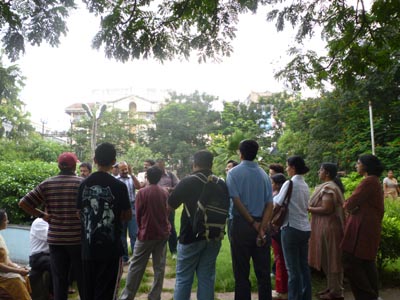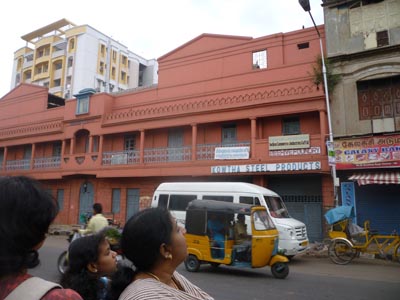|
About 30 of us recently went on a heritage walk on Broadway, once the city’s principal thoroughfare in its main business district. This road cuts George Town into two unequal parts, Muthialpet and Peddanaickenpet. It is difficult to imagine today that the road owes its existence to the vision of Stephen Popham, the lawyer turned entrepreneur and prospector, who recommended that the ditch that ran north to south through Black Town be filled with the sand and rubble removed while flattening Hog Hill that stood near present-day Central Station.

At Loane Square park. |
We entered Broadway at the Ibrahim Sahib Street end (the north end) and made our way towards NSC Bose Road at the south end. Near the beginning of the road stands Bharati Women’s College, on the site of what at one time was the city’s main jail before the Central Prison came up in Park Town. After the jail days, it became a cottage industries training centre thanks to the vision of K. Kamaraj. Still later, it was used by the Central Polytechnic and when the trainees moved out it became the present-day women’s college. Other old educational institutions on this road include the Muslim School for Girls (now closed), Bishop Corrie’s High School (begun as the Parental Academy in 1936) and Don Bosco.
Broadway had much to do with the history of some of the newspapers and periodicals of Madras. It was here that two lithographers, the father and son duo of John and Justinian Gantz, ran the Madras Times in 1859. They also acquired The Spectator which had begun in 1836. In 1868, Charles Lawson and Arthur Cornish, who edited the Madras Times, left it and set up The Madras Mail on Second Line Beach. By the 1920s, the Madras Times and The Madras Mail had merged to become The Mail. Another newspaper that began on Mooker Nallamuthu Street, a cutting off Broadway, was The Indian Express, occupying The Hindu’s first home. The Ananda Vikatan functioned for long from a lovely Indo-Saracenic building on Broadway. This still survives, though a notice on the door stated that the property was shortly to be auctioned. It was also on Broadway that the Brahmavadin, a philosophical magazine, was started in 1895, inspired by Swami Vivekananda. This later metamorphosed into the Vedanta Kesari, which continues to be in print even today.

Original homes of Oakes. |
Broadway has several churches, two of the oldest being the unfortunately named Loveless (now the William Charles) Church, which stands on Davidson Street just off the main road from its consecration in 1810. The Rev Charles Loveless who established it was the first British missionary to arrive in Madras. Ten years later was established Tucker’s Church. The Mission Hall of Tucker’s stands opposite the Church and is a thing of beauty, though it is very poorly maintained.
Two culinary institutions of Madras owed their initial success to Broadway. Harrison’s, now a modern hotel in Nungambakkam, began life here in 1891. Once a restaurant famed for its officers’ lunches, its string band and confectionery section, it moved to Nungambakkam and became the multi-storeyed hotel that it is now. P. Venkatachellum’s is the other famed name here. Begun in 1860, it was a well-known brand of condiments and pickles, its main markets being abroad. The institution occupied almost the first few blocks of Broadway right up to Umpherson Street. Today, it is a mere shell of its former self and survives in Mylapore. Also on Broadway was Oakes & Co. Begun in 1843 as Oakes, Partridge and Co, it was Madras’ first department store, selling everything short of a “wife or housekeeper”. Later, it was taken over by Spencer’s.
Oakes’ Beehive Foundry, a name that still survives, was established in these premises. This, one of the earliest metal-working businesses of Madras, was later acquired by Kowtha Suryanarayana who was known as much for his business acumen as for his love for music and his penchant for charitable works. The family still controls the business which continues to operate from the old premises. Next door is Sharafally Building, commemorating an old (and now non-existent) name in hardware – Mohammed Ali Sharafally & Co. On the same stretch stands Broadway Theatre, opened in the 1920s and still in business.
Closer to the NSC Bose Road end stands the building that houses the century-old Sukrutha Lakshmi Vilasa Sabha that was set up as a dramatic society to rival Pammal Sambanda Mudaliar’s Suguna Vilasa Sabha. Today, both organisations are mere social clubs. But the building occupied by the Sukrutha Lakshmi is an interesting one for, according to Dr. Stephen Hughes, one of the finest scholars on Tamil cinema, this could be the place where Madras’s first theatre – Mrs. Klugg’s Bioscope – may have functioned. Sadly, this cannot be said so with certainty. Also unidentifiable today is the building in which the first private nursing home of Madras, that of Dr. T.A. Sankaranarayanan, came up on Broadway in 1914. Another historic building, that of the leading exporters of hides and skins in their time – the South Indian Export Company – has long gone, but its site can still be identified.
As we stand at the point where NSC Bose Road intersects Broadway, we reflect on why the road was renamed Prakasam Salai. When the Simon Commission came to India, a protest march was organised down Broadway. As the procession reached China Bazaar (now NSC Bose) Road, the police opened fire. One of the protestors, Parthasarathy, was killed. The body lay at the intersection and the police announced that anyone coming forward to claim it would meet with the same fate. That did not deter T. Prakasam, well-known lawyer and patriot. He bared his chest and darted forward. The police realised that the situation could get out of hand and held its fire. Prakasam later became the first Prime Minister of Madras State after Independence and then of Andhra Pradesh as well. A statue of his stands a short distance away.
Broadway may be a civic disaster today, but its history is an exciting one.
|